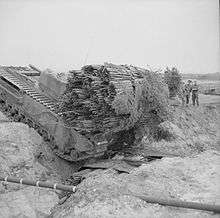Fascine

A fascine /fəˈsiːn/ is a rough bundle of brushwood or other material used for strengthening an earthen structure, or making a path across uneven or wet terrain. Typical uses are protecting the banks of streams from erosion, covering marshy ground and so on. In war they are often used to create paths for tanks and other vehicles across uneven terrain.
Early military use

Fascine bundles were used in military defences for revetting (shoring up) trenches or ramparts, especially around artillery batteries, or filling in ditches from earlier military actions. They were also used as a visual obstruction, providing cover for sappers and engineers. Military fascine bridges were used on a regular basis by the Romans to cross obstacles. Subsequently, the use of fascines by military engineers continued almost wherever armies were deployed.
World Wars


First World War tanks, namely the British Mark IV, started the practice of carrying fascines on the roof, to be deployed to fill trenches that would otherwise be an obstacle to the tank.[1] These were constructed from the traditional bundles of brushwood used to make fascines since Roman times. Although these were cumbersome to deploy they proved an effective gap crossing device and were used widely by the tanks of the day that weighed up to about 30 tons.
In World War II the use of fascines continued as a gap crossing device and within the British Army these were launched from the Churchill AVRE - a Royal Engineer derivative of the standard Churchill tank (40 tons).
The Imperial Japanese Army (IJA) pre-positioned fascines made of metal pipes across the Khalkha River (between Japanese held Manchuria and Mongolia, the USSR's protectorate,) in advance of the IJA's 1939 foray into Mongolia. The use of hollow pipes had been predicated on their ability to allow water flow; the pipes were secured such that they were awash, and the river's unimpeded flow initially hid the fascines from Soviet reconnaissance aircraft. While these fascines were designed for stealth rather than combat deployment and were not deployed via armoured vehicles, the use of hollow pipes as fascines was a significant step forward.
Developments since World War II
The pipe fascine was further developed in the British Army in the early 1980s to meet the challenges of assuring the mobility of movement in West Germany in the event of a NATO conflict with the Warsaw Pact.

The majority of obstacles to mobility in West Germany run north–south, and movement by military forces would have been east–west. Within the area of operation of the British Army, near Hannover, there is a significant number of smaller gaps, mainly drainage ditches, streams and small rivers approximately 5–10 m wide and 1.5 – 2.5 m deep that are sufficient to stop armoured vehicles. Given the low number of AVLBs available, a solution was needed to bridge these gaps quickly and cheaply and under fire. In earlier wars, wooden fascines had been used, but these were ineffective for use with the much heavier modern vehicles, some of which weighed up to 70 tons.
The Royal Engineers Experimental Establishment at Christchurch did initial tests on the possible use of 9-inch high-density plastic pipes held together with chains. These would allow water flow, and not be damaged with the higher modern vehicle weight. Further development was done by Lt C Roebuck RE and his troop, 5 Troop, 31 Armoured Engineer Squadron, 32 Armoured Engineer Regiment at Munsterlager, North Germany in 1981/2, to enable full acceptance and provide user instructions for operational use. This development involved testing in different gaps and conditions, eg concrete line canals to earth banked rural field drainage channels,possibility of multiple fascine use in a single gap and launch testing both day, night and in limited visibility. During the trials the development team drivers became skilled at the launching of the fascine and were able to launch two or even 3 fascines into a single gap. However for regular operational use by less skilled crews it was recommended that only single fascines should be used as the use of 2nd or 3rd fascines required the launch vehicle to launch the subsequent fascine whilst on the potentially unstable first fascine. This required a perfect launch to ensure the second fascine was quickly in place to make the first fascine stable and held in position. If this did not happen there was potentially significant risk to the launch vehicle and crew especially in water filled gaps.
A launch technique was developed: approach the target gap at speed, line up onto alignment/ launch markers, drive over first marker then brake sharply at second marked point and fire the explosive bolts holding the travel hawsers so that the fascine, through inertia, rolled off the directly into the middle of the gap. When in position, they travel over it to level the road surface for other vehicles to cross. This whole process would take less than 1 minute, essential for an assault crossing possibly under fire.

The fascine was subsequently accepted into service and used successfully in a number of operational and non-operational roles using the Centurion AVRE, a Centurion tank derivative with a bulldozer blade and 165mm demolition gun fitted. It was used in combat for the first time during the First Iraq war to breach anti tank ditches. The British Army now use the Trojan, based on the Challenger 2 tank, to carry and deploy pipe fascines.
See also
References
- ↑ First World War - The Tank: New Developments - Willmott, H.P., Dorling Kindersley, 2003, Page 222
External links
| Wikimedia Commons has media related to Fascines. |